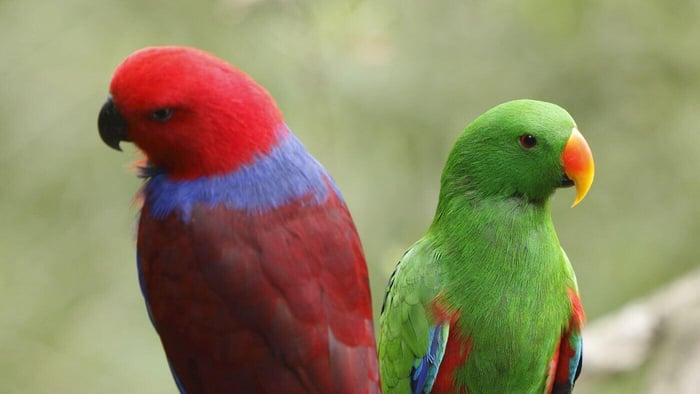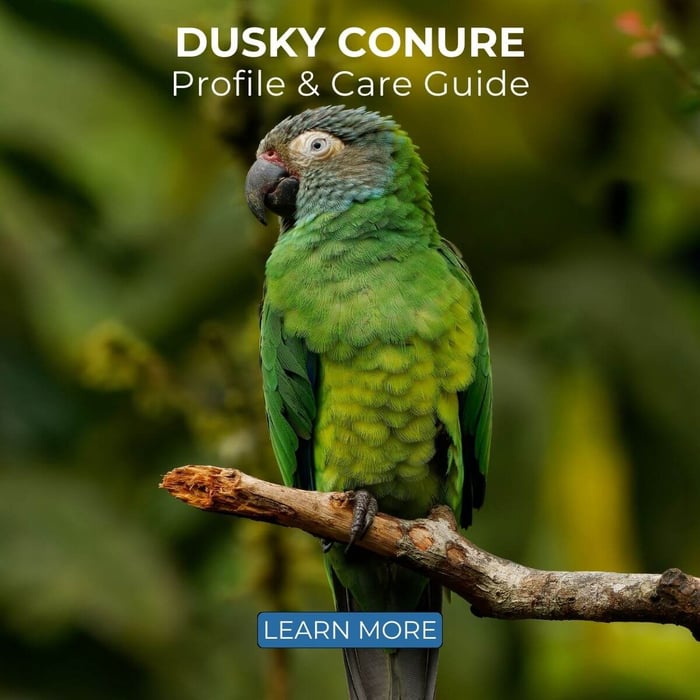Eclectus Parrot Profile & Care Guide
| Common name: | Eclectus parrot |
| Scientific name: | Genus Eclectus |
| Length: | Up to 35 cm |
| Weight: | Up to 450 grams |
| Lifespan: | 40+ years |
| Origin: | Southeast Asia and Oceania |
| Noise Level: | Medium |
NATURAL HABITAT

The four species of Eclectus are naturally found in Southeast Asia and Oceania. They're particularly common in Australia (Northern Queensland) and New Guinea, but also occur in Indonesia and the Solomon Islands. In their natural habitat, they inhabit lowland and hilly forests at altitudes of up to 1,900, usually staying in the canopies and rarely coming down to the ground.
The species isn't particular about the type of forest as long as there are plenty of fruit trees around for foraging and tree holes for nesting. It has been spotted in rainforests, swamps, mangrove forests, agricultural plantations (where it may raid farmers' crops), and even parks and gardens.
ECLECTUS PARROT INTELLIGENCE & PERSONALITY
Eclectus parrots, like most of their parrot cousins, boast an impressive intellect. They possess impressive problem-solving skills, which help them find food in the wild, and they actually seem to enjoy solving puzzles. They're also highly social and can grow incredibly close to their human "flocks". Eclectus owners consider them relatively calm—unless they get excited, in which case they can be quite rowdy—and gentle. A well-socialized Eclectus parrot will generally be affectionate and thrive on being included in the family.
Both social interaction and mental engagement are crucial for the mental and even physical health of your Eclectus parrot. They easily become bored and lonely, which can lead to undesirable behaviours like excessive vocalization, biting (which is problematic given the size of their beaks!) and even feather plucking.
Owning an Eclectus means being available for your bird almost all day long; if you work a regular job, you'll have to get two birds so they can keep each other company. You'll also have to spend time training your bird daily and always be on the lookout for new ways to keep it entertained. Most casual bird enthusiasts aren't willing to commit to this level of dedication, but for those who are, owning an Eclectus parrot can be an incredibly rewarding experience.
ECLECTUS PARROT NOISE LEVEL & TALKING ABILITY
Eclectus parrots are considered moderately noisy as far as parrots go. Eclectus owners generally report their birds being relatively calm and quiet, but the issue is that when they do vocalize (like when they're bored, excited, want something, and usually around dawn and dusk), their flock calls, squawks, and whistles can be very loud. They don't make the best birds for flat dwellers, and it's important to consider whether you can handle the noise before adding one to your family.
As for talking ability, yes, Eclectus parrots can mimic human speech—and they're quite good at it, too. Males are generally better at talking than females, but both can learn. Their voices are quite clear, they can build impressive vocabularies, and they even appear to be able to use words in context (like saying "hello?" when the phone rings, for example).
Do keep in mind that not every Eclectus will possess the same talent for mimicry. You should never get a parrot just because you hope it will talk; some never do, and there is a lot more to being a parrot owner than enjoying their talking abilities. Even if your bird does pick up the skill easily, it still requires a lot of patience and repetition. Additionally, it can get pretty annoying! It's all fun and games until your parrot starts imitating a low-battery fire alarm and you can't get it to stop.
FEEDING & NUTRITION FOR YOUR ECLECTUS PARROT
Eclectus parrot diet is quite unusual as far as parrots go. To put it simply, these birds possess a longer digestive tract than many other psittacines. This means they digest foods more thoroughly, allowing them to effectively break down higher amounts of fibre.
In the wild, eclectus parrots feed on a range of different foods: fruits, nuts, flowers, flower and leaf buds, seeds, and more. In captivity, they can't be fed a standard parrot diet, and their digestive systems are a bit more sensitive than many of their cousins. It has been suggested that this is because, with a longer digestive tract, they absorb more nutrients from their food—sometimes too much.
If you'd like to keep your Eclectus parrot healthy and improve its chances of growing old, don't feed it like you would a granivore such as a budgie or a cockatiel. Eclectus gizzards are not used to all those crunchy, dry foods; they need more fresh produce. But how does one do this when the fruits we find in the supermarket tend to be cultivated to be sugary but low in nutrients? These fruit cultivars are not at all similar to the wild, often much more starchy fruits these birds naturally eat.
Although more research is still needed, Eclectus parrot experts tend to lean towards the following:
- Plenty of cooked vegetable matter like squash and sweet potato
- Some cooked legumes and grains like lentils, pasta or rice
- A degree of "human" fruits like mango, pomegranate and figs
Really be sure to make the veg and fruit the vast majority, around 80%, of your bird's diet. Most Eclectus owners try not to feed their birds pelleted foods at all. If you do decide to offer pellets occasionally, make sure they're all-natural.
Did you know? Eclectus parrots are sensitive to a phenomenon called toe tapping, which is not really harmful in itself but can be an indication that there's something wrong with their diet. It has been recommended to avoid any vitamin-fortified foods (they can absorb too many nutrients from these), processed human foods, and spirulina.
Toe-tapping. From The Combined PerspectivesHOUSING FOR YOUR ECLECTUS PARROT
One of the most important parts of owning a parrot is to provide adequate housing for your bird. Even if they're allowed out for most of the day, their cages are their homes and where they feel safe. If you don't plan on letting your bird fly free at least a few hours a day, you should get a full-sized aviary; otherwise, go for the largest you can fit in your home, with a minimum of 45" in width. The bars should be no more than 1" apart and the cage should be made of a sturdy material, with an extra-safe lock.
To prevent boredom and keep your Eclectus content, fill the cage with engaging chew toys, foraging toys, preening toys, and other interesting items for your bird to climb and destroy. Various natural wood perches can help keep their feet and nails in good condition; they should mostly be placed near the top of the cage, where parrots prefer spending their time.
Place the cage in a part of the house that allows your bird to be part of family activities and observe its surroundings, but away from potentially harmful kitchen fumes, direct sunlight and heaters, or drafts and air-conditioning units.
As your Eclectus should ideally spend as much time as possible each day outside its cage, it can be helpful to set up a cage-top play gym with toys, as well as food and water bowls. Many parrot enthusiasts also opt for a portable parrot tree, which allows you to always have your bird close while you go about your daily activities.
FEATHER PLUCKING IN ECLECTUS PARROTS
Eclectus parrots are, unfortunately, relatively prone to feather plucking. This addictive habit, which involves the bird damaging and pulling out its own feathers or even damaging its own skin, is a sign of distress. Common causes include boredom, loneliness, hormonal imbalances, and physical problems.
Nutritional issues are common in Eclectus parrots due to their unusual diet, so if your bird seems to be picking at its feathers, the first step is to take it to a veterinarian and have them run some tests. They can tell you whether the problem can be fixed with diet tweaks or whether you should provide more and better enrichment to keep your parrot's super-smart brain busy. The sooner you break the bad habit, the better!
FACTS
- Until 2023, only one species of Eclectus parrot was recognized: the Moluccan Eclectus, E. roratus. However, in 2023, based on a study published in 2017, the genus was split into four. It now also contains the Sumba Eclectus (E. cornelia), Tanimbar Eclectus (E. riedeli), and Papuan Eclectus (E. polychloros). The differences between the species are relatively subtle, though.
- There used to be a fifth species of Eclectus parrot. It was called the Oceanic Eclectus (scientific name E. infectus), and it likely inhabited Tonga, Vanuatu, and Fiji. It's thought to have been wiped out here around 3,000 years ago as a result of humans settling on the islands.
- Unfortunately, some of the remaining Eclectus parrot species appear to be heading in the same direction as the Oceanic Eclectus. The Sumba and Tanimbar species are considered Endangered and Vulnerable by the IUCN, with trapping for the pet trade and deforestation listed as the primary threats.
- The extreme sexual dimorphism of Eclectus parrots is quite unique to the genus. Males are bright green with red wing undersides, colouration that is thought to serve a camouflage purpose as they search for food for the female and chicks. Females are dark red with dark blue bellies, which ornithologists think helps to attract mates to their nesting hollows.
- Eclectus parrots are also unusual in that they're not quite as monogamous as parrots tend to be. Females mate with multiple males, and males may also mate with multiple females. Additionally, they're cooperative breeders, with up to five males feeding a single female while she guards the nest and cares for the chicks.

CONCLUSION
Eclectus parrots are renowned for the striking colour difference between male and female birds. These intelligent bird tend to be calm and affectionate, but keep in mind that they don't make the best choice for first-time parrot parents due to their highly specific dietary needs.
To view other Parrot Profiles & Care Guides, visit our Alphabetical list of Parrot Fact Sheets by visiting: https://parrotessentials.co.uk/blog/parrot-profiles-care-guides




